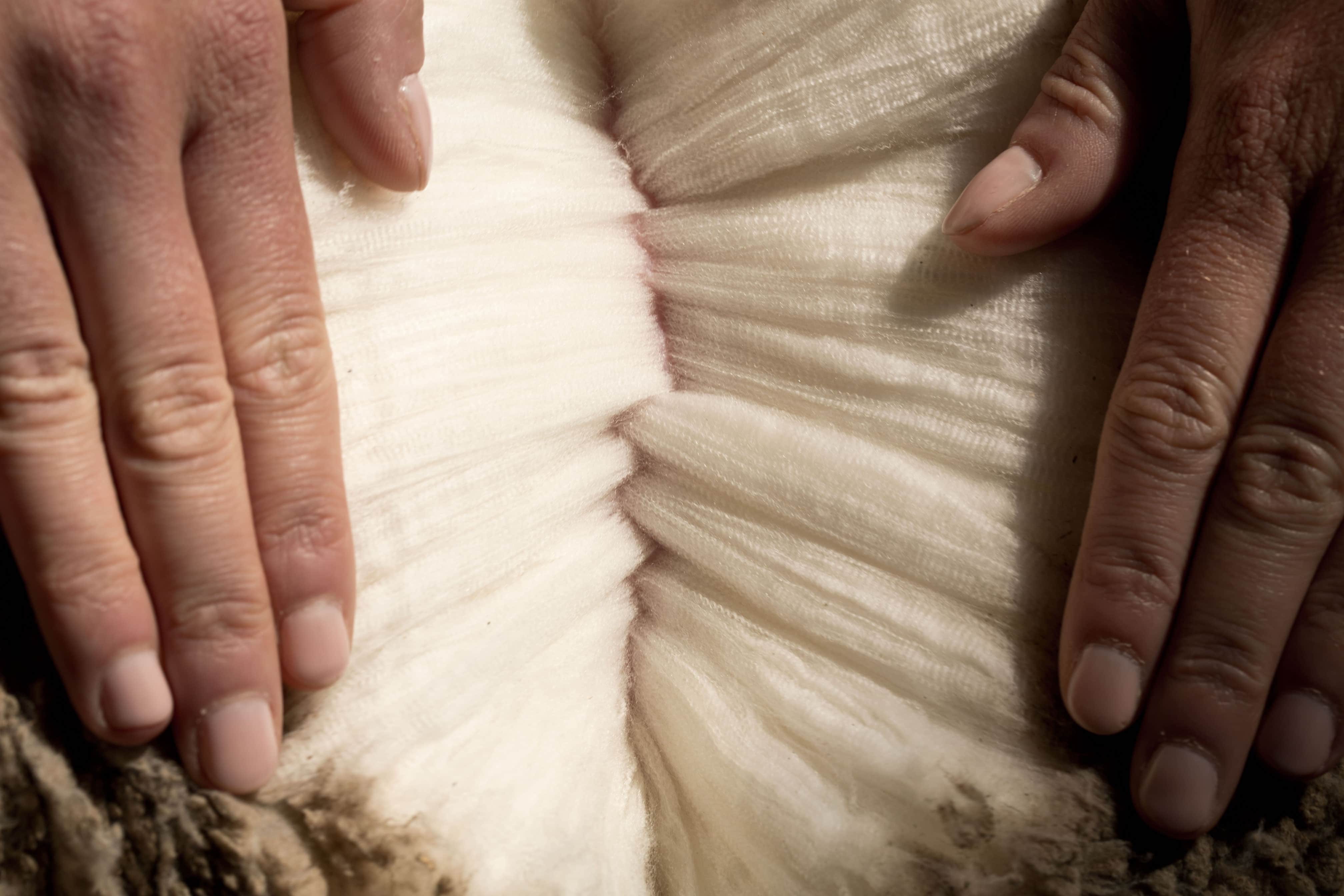When it comes to natural fibers, cashmere and Merino wool are two great options if you’re looking for a luxury feel. Both have long been coveted for their softness and warmth, yet they each have different strengths.
Cashmere can be a big investment (as Wirecutter says, “soft on the skin and rough on the wallet”), and Merino wool clothing isn’t cheap either, so here are a few things to consider if you’re comparing these natural fibers.
Where Do Cashmere and Merino Wool Come From?
Merino wool comes from the Merino breed of sheep, primarily raised in Australia and New Zealand. Compared to traditional wool, Merino wool is known for its incredibly soft and fine fibers that aren’t itchy.
Cashmere comes from Kashmir goats that are typically raised in China and Mongolia. Kashmir goats (named for the Kashmir Valley) live high up in the mountains, and to deal with frigid mountain temperatures, they have two coats of hair: a wiry topcoat and a super soft cashmere undercoat.
Both Merino wool and cashmere can only be harvested once a year in the spring. Merino sheep are shorn (a sheep haircut), which prevents their wool from getting too long and keeps them cool in the summer, and their hair gets woven into Merino wool.
Kashmir goats are usually combed rather than shorn. In the spring these goats naturally shed their undercoat so they can stay cool in the summer. That undercoat is carefully combed out and used to create cashmere. Combing makes sure the softest and finest fibers are collected and avoids the goats’ coarser topcoat hairs.
Much less fiber is collected from Kashmir goats compared to Merino sheep, and it’s a more labor-intensive process, which contributes to cashmere’s high price tag.

Which Material Is Softer?
Merino wool is softer than most other types of wool, but since cashmere comes from a delicate undercoat, it’s even softer. Cashmere has a very fine micron count, usually 14 to 19 microns, which is finer than most Merino wool (most of our Merino wool clothing is 17.5-18.5 microns).
Merino Wool vs. Cashmere Performance
How clothing performs is what matters most to us and our customers. When comparing cashmere vs. Merino wool performance, Merino is the clear winner, but we’ll explain why.
Durability
Since cashmere comes from the super soft undercoats of Kashmir goats, it’s far more delicate than Merino wool. Cashmere can be blended with other materials like cotton or even Merino wool to increase durability. Most cashmere clothing is too delicate to wear for outdoor recreation.
In some of our products, we blend Merino wool with polyester or nylon for extra durability. But thanks to Merino wool’s inherent strength, we can use very small amounts of these synthetic fibers to make great clothing for skiing, hiking and backpacking, while still keeping the natural fiber content high.
Meticulous care is key for cashmere garments and accessories. We wouldn’t wear cashmere on hikes, in the mountains, or anywhere clothing might get snagged. But cashmere is also more complicated to clean than Merino wool. Most Merino wool clothing can be machine washed on cold and hung to dry, but cashmere usually requires dry cleaning or very gentle handwashing. Cashmere is more prone to pilling as well.
Both materials are pretty good at retaining their shape over time and can last a long time if properly cared for.
Warmth & Temperature Regulation
Both fibers provide plenty of warmth, but cashmere clothing is even warmer than Merino wool clothing. For functional warmth for outdoor use, Merino wool garments are the way to go since there are many more performance-oriented options.
A cashmere sweater will keep you warm, but it’s usually bulkier if you need to stuff it in a pack, harder to clean once you’re home, and lacks performance features you’ll find in Merino wool outdoor clothing (like our quarter zip base layer that allows for easy ventilation on the move).
Both cashmere and Merino wool are good at temperature regulation, but cashmere clothing tends to be more oriented toward winter use. People often pack away cashmere sweaters for the summer – a process that must be carefully done to ensure the garment stays in good shape for the next winter.
If you want to find cashmere made for summer wear, look for lighter summer-weight cashmere. Thinner doesn’t necessarily mean cheaper though. Many Merino wool garments are made to be worn year-round.
Moisture Management
Merino wool is known for its moisture-wicking abilities. It pulls moisture (sweat) off your skin and absorbs it, and it can hold up to 30% of its weight in water. Cashmere is able to wick moisture too, but it typically doesn’t do as good of a job as Merino wool.
Odor Resistance
Both Merino wool and cashmere are naturally antibacterial and odor resistant, keeping you stink-free even on hot days.

Sustainability
Natural fibers like Merino wool and cashmere tend to be better for the environment than synthetics like polyester and nylon. Both cashmere and Merino wool can be sustainably produced if standards are adhered to.
Wool can be certified via the Responsible Wool Standard (RWS), a certification given at the farm level. Cashmere’s sustainability can be verified by The Good Cashmere Standard or the Sustainable Fibre Alliance’s Cashmere Standard. Occasionally you’ll see the Global Organic Textile Standard (GOTS) for organic farming practices or OEKO-TEX Standard 100 for textiles that are free of harmful substances.
Cashmere production has long faced criticism for its environmental impact. Goats tend to be more destructive than other livestock to grasslands since they eat plants down to the roots. Sheep just nibble the tops of grass. A 2018 report found that nearly 58 percent of Mongolia’s rangeland had been degraded from grazing.
“My view is this: From an environmental perspective, the best solution is to forgo cashmere altogether. Wool from sheep, yaks or camels can still be made into very soft fabrics. These animals can also produce much more fiber a year than cashmere goats without causing the same level of ecological damage. Or consider vintage cashmere.” - The New York Times Opinion
For all these reasons, Merino wool is the more sustainable choice. Whether you buy Merino wool or cashmere, investing in natural clothing instead of clothing made from petroleum-based fabrics reduces microplastic pollution, which is good for the earth.
Skin Sensitivities
Both Merino wool and cashmere are soft and comfortable and tend to work well even for people with sensitive skin. But everyone is different, so the best way to confirm is to try wearing both types of garments. Merino wool does contain lanolin, which – although rare – can be an allergen, and cashmere does not.
The Cost of Cashmere vs. Merino Wool
Prices vary for both cashmere and Merino wool clothing, and we’re increasingly seeing cheaper options on the market. But you typically get what you pay for. Overall, Merino wool clothing and accessories tend to be cheaper than cashmere clothing and accessories.
Cheaper cashmere clothing might include more of the rough topcoat and less of the super soft undercoat from Kashmir goats, so it may be less comfortable and less soft. To make one cashmere sweater, you need about four Kashmir goats. A single sheep can provide around 4.5 kg of wool per year, which is enough to make five or six sweaters.
“When sheep are sheared, one animal can fill a garbage bag with fleece. When one cashmere goat is brushed, the fibers will fill a one-gallon ziplock bag. In general, it takes four goats one year to produce enough cashmere for an adult sweater. That’s why you’ll pay top dollar for that sweater.” - Successful Farming

Choosing Between Merino Wool and Cashmere
When it comes to choosing cashmere vs. Merino wool, the decision depends on your needs. If you’re looking for an incredibly soft and cozy sweater to wear at home or out around town and don’t care about cost, cashmere is a great choice.
But if you need versatility, durability and high performance to keep you comfortable outdoors, Merino wool is what you want. Because of its ability to perform well in extreme conditions and be worn in many different settings, Merino wool is the fabric of choice for people who love spending time outdoors.




